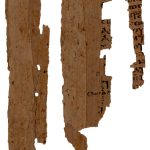| Artefact ID | 1771 |
| TM ID | TM 983376 |
| Findspot (DEChriM ID) | 8 (Umm al-Dabādīb) | Class | Textual |
| Material | Papyrus |
| Writing medium | Codex |
| Text content | Literary |
| Language | Coptic |
| Description | P. Dabadib inv. 3. Three fragments from a papyrus codex in Coptic. The fragments probably belonged to three different pages. Few letters are readable, which does not allow for any sequence to be reconstructed. For the same reason, the dialect cannot be identified. Remains that the literary content is almost certain. Parepigraphic signs are, indeed, consistent with those employed in literary codices. Among these, stands out, on the left margin of the verso, what the ed. qualifies as a coronis, which resembles rather a large cross composed of various traits and dots and provided with rings at its three visible ends. The symbol is also too high (3 cm) for it to be a coronis, particularly in a fourth-century codex. |
| Selection criteria | Christian symbols/gestures/isopsephy, Writing medium suggestive of Christian context, Archaeological context associated with Christian markers |
| Date from | 300 |
| Date to | 382 |
| Dating criteria | Palaeography. The ed. sees similarities between the hand of the present fragments and those of P.Bodm. 18, P.Bodm. 23 and the Nag Hammadi codices (Rossi, Delattre, Bagnall 2024: 98). |
| Absolute/relative date | Relative date |
| Archaeological context | Room 2-9, on the second level of the fort of Umm al-Dabādīb. The room had been looted between 2007 and 2013, and again between 2016 and 2022. The papyri were found in May 2022, not on the floor of the room 2-9, but inside a "50-cm-thick layer of fine sand that covered the northwestern corner of the room" (Rossi, Delattre, Bagnall 2024: 94). How distrubed the layer in question was prior to the unearthing of the papyrus fragments is unclear. |
| Accession number | Egypt, Umm al-Dabādīb, P. Dabadib inv. 3. |


 Json data
Json data





